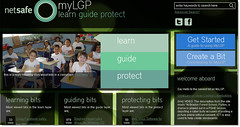 Image by hazelowendmc via Flickr
Image by hazelowendmc via FlickrToday was the first session of the Paepae Hot Seat session, Digital Citizenship and Online Safety, kindly facilitated by Nancy Groh from Netsafe. Netsafe are the developers of the Learn, Guide, Protect site, where educators and the wider community can share resources around digital citizenship and online safety. The idea is that educators develop "an online repository of material schools can use and adapt to promote a student-centred approach to digital citizenship and cyber safety" (Nancy Groh).
Nancy opened by asking everyone to introduce themselves and where they currently are, in the chat box - a nice way to see who is doing what as well. She then moved on to a short re-cap of using computers and cybersafety since 1998. It was amazing to see that no-one in the group were using computers in classrooms in 1998, and no one had cell phones. The phenomenal changes since then were then described, and ICT was seen as the norm, and those that don't have Internet access are now marginalised. Her own son came across the situation where 4 out of 5 universities had no other way to apply to them except online.
 Image by whurleyvision via Flickr
Image by whurleyvision via FlickrMobiles and consoles are now seen as 'the net', and provide 'Google in the pocket'. Nancy then went on to say that it's not just in the pocket, but also in the kitchen, bedroom...and bathroom!!!
Nancy covered the four 'truths' of cybersafety. The message is that if something worries a person that is online, that they should tell a significant adult about it. The problem is that many people speak to peers rather than approaching 'authority' figures.
In a short survey conducted with the audience when showed an image of a girl at a school crossing, about 42% felt the child was safe, for a range of reasons such as visibility, and adult supervision. If the adults are taken out of the picture, 42% also agreed that she was safe...but with the caveat that it depended on her prior experience and training. The discussion was then tied to the three elements of learn, guide, protect, and then Nancy introduced another picture with two young students in front of a laptop with no clues around external context, and asked "how safe are these girls?". It was interesting the discussion in the backchannel around this point including "depend on many other surrounding factors", and "Very few kids know the problems...just think they do".
From the NZ Curriculum key competencies Nancy showed nine points about what makes a digital citizen. On the list 'ethical behaviours' and 'critical thinking' were highlighted in a different colour. Research Nancy has conducted suggests that the ICT words should be taken out of the list of digital citizen descriptors, and that the behaviours described should be across the board, not purely online. A diagram was used to illustrate some of the key aspects of cybersafety conceptually. The combination of key competencies and digital capability are shown as all parts of the same conversation.
In further research Netsafe has conducted, the percentage of educators who believed that their students understand ICT use agreements, about 30% disagreed or were not sure that students understood the ICT use agreement that they had signed. The real challenge around the concept of digital citizenship has to bring in the context in which you are working. Nancy shared two images, one of a nude male and one of a sculpture and asked participants to think about their reaction if they saw a 7 year old student looking at the images if they were studying photography or classics, and in a situation where they weren't. Would we react any differently? If someone else who was unaware of the context in which they were being used saw the 7 year old student viewing, how might they react? A really interesting point!
Bullying was discussed, and it was suggested that there is often a small, identifiable group that is often the main source of bullying within a school. As such, targeted education around bullying has been found to be effective. Surveys were also identified as a good first step to outlining a school culture - and the surveys can be (and have) be conducted and presented by the students themselves. Other strategies are more senior students working with younger students to help them with cybersafety and provide peer support.
 Image via Wikipedia
Image via WikipediaInvolving parents was seen as an interesting challenge. Willowbank School in Auckland was talked about as an example where the school is using Facebook to communicate with parents. It's a primary school, so there was a lot of discussion with the students as why this is happening. The parents have responded very positively around the enhancement to the communication. Bring your own device was mentioned as another challenge (as well as the incredible benefits) - but again, it was seen as incredibly important to involve parents.
The session was tied up with a discussion around some of the key points that had been raised, including the issue of support within schools for teachers who become enthusiastic about innovations, only to not receive the support and become dispirited.
A very informative, thought-provoking session with a very lively backchannel! If you are interested in finding out more about what happened during the session, please access the recording at:






No comments:
Post a Comment